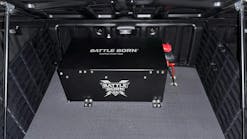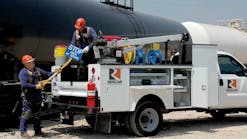The Commercial Vehicle Safety Alliance’s (CVSA) Brake Safety Week is scheduled for Sept. 15-21.
Throughout that week, enforcement officials will conduct roadside safety inspections on commercial motor vehicles throughout North America. Vehicles with critical brake violations, or other critical vehicle inspection item violations, will be restricted from traveling until those violations are corrected. Vehicles without critical vehicle inspection item violations are eligible to receive a CVSA decal indicating the vehicle passed inspection.
During this year’s Brake Safety Week, inspectors will be paying special attention to brake hoses/tubing. While checking these brake system components is always part of the North American Standard Inspection Program, CVSA is highlighting brake hoses/tubing as a reminder of their importance to vehicle mechanical fitness and safety.
Routine brake system inspections and component replacement are vital to the safety of commercial motor vehicles. The brake systems on commercial motor vehicles are comprised of components that work together to slow and stop the vehicle and brake hoses/tubing are essential for the proper operation of those systems. Brake hoses/tubing must be properly attached, undamaged, without leaks and appropriately flexible. Brake hoses/tubing are an important part of the braking system so when they do fail, they can cause problems for the rest of the braking system.
“We all know how important a properly functioning brake system is to vehicle operation,” said Jay Thompson, CVSA president and chief of the Arkansas Highway Police. “All components of the brake system must always be in proper operating condition. Brake systems and their parts and components must be routinely checked, and carefully and consistently maintained to ensure the health and safety of the overall vehicle.”
Out-of-adjustment brakes and brake-system violations represented 45% of all out-of-service vehicle violations issued during last year’s three-day International Roadcheck enforcement campaign. And, according to the Federal Motor Carrier Safety Administration’s (FMCSA) 2018 Pocket Guide to Large Truck and Bus Statistics, brake-related violations accounted for six of the top 20 most frequently cited vehicle violations in 2017.
The goal of Brake Safety Week is to reduce the number of crashes caused or made more severe by faulty brake systems on commercial motor vehicles by conducting roadside inspections and identifying and removing unsafe commercial motor vehicles from our roadways.
In addition to inspections and enforcement, outreach and awareness efforts by law enforcement agencies to educate drivers, motor carriers, mechanics, owner-operators and others on the importance of proper brake maintenance, operation and performance are integral to the success of this safety initiative.
In the 14 jurisdictions using performance-based brake testers (PBBT), vehicle braking efficiency will be measured using that tool. PBBTs determine overall vehicle braking efficiency or the total brake force over the effective total gross weight. The minimum required braking efficiency for trucks or combinations with gross vehicle weight rating above 10,000 pounds is 43.5%, required by 393.52 of the US Federal Motor Carrier Safety Regulations and the CVSA North American Standard Out-of-Service Criteria.
Brake Safety Week is part of the Operation Airbrake Program, sponsored by CVSA in partnership with FMCSA and the Canadian Council of Motor Transport Administrators.









